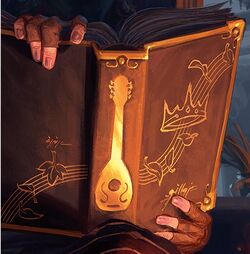Class: Difference between revisions
>Falconfly |
>Falconfly |
||
| Line 25: | Line 25: | ||
*<c>Cleric Class</c> ({{W}}, [[Cleric]]) | *<c>Cleric Class</c> ({{W}}, [[Cleric]]) | ||
*<c>Druid Class</c> ({{G}}, [[Druid]]) | *<c>Druid Class</c> ({{G}}, [[Druid]]) | ||
*<c>Fighter Class</c> ({{R/W}}) | *<c>Fighter Class</c> ({{R/W}}, [[warrior]]) | ||
*<c>Monk Class</c> ({{W/U}}, [[Monk]]) | *<c>Monk Class</c> ({{W/U}}, [[Monk]]) | ||
*<c>Paladin Class</c> ({{W}}, [[knight]]) | *<c>Paladin Class</c> ({{W}}, [[knight]]) | ||
Revision as of 12:26, 16 July 2021
- This page is about enchantment type. For the subset of creature types, see creature class.
| Class | |
|---|---|
| Enchantment Type | |
| (Subtype for enchantment cards) | |
| Rules | Gain the next level as a sorcery to add its ability. |
| Statistics |
12 cards |
| Scryfall Search | |
| type:"Class" | |
Class is an enchantment subtype introduced in Dungeons & Dragons: Adventures in the Forgotten Realms.[1][2][3][4]
Description
Classes act as they would during a game of D&D. They are similar to the Level up mechanic, and have effects that stack as you level up.[5]
Each Class has three abilities in sections of its text box, called Class abilities. The abilities are arranged vertically like Sagas, and has vertical artwork to match. The first Class ability is active as long as you control the Class. The next two are activated abilities that allow it to level up. A Class ability is activated at sorcery speed, meaning during your main phase if the stack is empty. As mana is paid for the second ability, the Class will become level 2 and the first two class abilities are active. If a Class is level 2, you can activate the level 3 ability. Note that you can only activate a Class's level 3 ability if the Class is level 2.
Class abilities can be anything — static abilities, activated abilities, or triggered abilities.
A Class's level isn't tracked with or represented by counters. A Class's level is just something true about the permanent.
List of Classes
In Dungeons and Dragons 5th Edition there are 12 classes in the Player's Handbook. Except for Fighter (corresponded as Warriors), Paladin (corresponded as Knights) and Sorcerer, each class has a corresponding creature class in Magic, though Bard and Ranger were only introduced at or near the release of Dungeons & Dragons: Adventures in the Forgotten Realms.
- Bard Class (
 , Bard)
, Bard) - Barbarian Class (
 , Barbarian)
, Barbarian) - Cleric Class (
 , Cleric)
, Cleric) - Druid Class (
 , Druid)
, Druid) - Fighter Class (
 , warrior)
, warrior) - Monk Class (
 , Monk)
, Monk) - Paladin Class (
 , knight)
, knight) - Ranger Class (
 , Ranger)
, Ranger) - Rogue Class (
 , Rogue)
, Rogue) - Sorcerer Class (
 )
) - Wizard Class (
 , Wizard)
, Wizard) - Warlock Class (
 , Warlock)
, Warlock)
Each card features the D&D symbol of the creature class in its art.
Rulings

- Each Class has five abilities. The three in the major sections of its text box are class abilities. Class abilities can be static, activated, or triggered abilities. The other two are level abilities, one activated ability to advance the Class to level 2 and another to advance the Class to level 3.
- Each Class starts with only the first of three class abilities. As the first level ability resolves, the Class becomes level 2 and gains the second class ability. As the second level ability resolves, the Class becomes level 3 and gains the third class ability.
- Gaining a level won't remove abilities that a Class had at a previous level.
- Gaining a level is a normal activated ability. It uses the stack and can be responded to.
- You can't activate the first level ability of a Class unless that Class is level 1. Similarly, you can't activate the second level ability of a Class unless that Class is level 2.
- You can multiclass or even control multiple Class enchantments of the same class. Each Class permanent tracks its own level separately.
- Some Class cards have an effect that increases when more are under your control. For example, if you have multiple Barbarian Class cards, you roll that many additional dice and ignore that many of the lowest rolls.
- The levels on Class cards don't interact with level counters of leveler cards or with the level up ability.
References
- ↑ Matt Tabak (July 2, 2021). "Adventures in the Forgotten Realms Mechanics". magicthegathering.com. Wizards of the Coast.
- ↑ A NEW Kind of Card?!? Previewing: Classes! (Video). Good Morning Magic. YouTube (July 2, 2021).
- ↑ Melissa DeTora (July 2, 2021). "Every Adventurer Needs a Class". magicthegathering.com. Wizards of the Coast.
- ↑ Jess Dunks (July 12, 2021). "Adventures in the Forgotten Realms Release Notes". magicthegathering.com. Wizards of the Coast.
- ↑ Mark Rosewater (July 12, 2021). "D&D-esign, Part 2". magicthegathering.com. Wizards of the Coast.
